6.-March-2011-Saving-Mothers-Lives-reviewing-maternal-deaths-to-make-motherhood-safer-2006-2008
6.-March-2011-Saving-Mothers-Lives-reviewing-maternal-deaths-to-make-motherhood-safer-2006-2008
6.-March-2011-Saving-Mothers-Lives-reviewing-maternal-deaths-to-make-motherhood-safer-2006-2008
You also want an ePaper? Increase the reach of your titles
YUMPU automatically turns print PDFs into web optimized ePapers that Google loves.
Lewis<strong>maternal</strong> mortality rates or ratios, they may contain importantmessages for the providers of maternity care. Clinically,the lessons may include basic principles for themanagement of pregnant or recently delivered women withunderlying medical or psychiatric conditions. From a public-healthperspective, the continuing assessment of such<strong>deaths</strong> re-enforces the need for information on the correctuse of seat belts in pregnancy, and, perhaps most importantly,the identification and management of pregnantwomen who suffer from physical, verbal or emotionalabuse. Issues related <strong>to</strong> domestic abuse, recommendationsand suggested guidelines have been fully described in specificchapters in the previous two Reports of this Enquiry.The main findings for this triennium, which remain largelyunchanged, are discussed at the end of this Chapter (inAnnex 12.1), and readers are referred <strong>to</strong> previous Reportsand other references for more detailed information.Summary of key findings for <strong>2006</strong>–08Coincidental <strong>deaths</strong>In this triennium, the <strong>deaths</strong> of 50 women who died ofCoincidental causes either during their pregnancy or within42 days of delivery were reported <strong>to</strong> this Enquiry, comparedwith 55 for the previous triennium. As in previousReports, and as shown in Table 12.1, the largest overall categorywere <strong>deaths</strong> due <strong>to</strong> ‘unnatural’ causes, largely roadtraffic accidents, murder or unintentional overdoses ofstreet drugs. Some women who died from other medicalcauses such as pneumonia are included in this section, astheir pregnancies (invariably at an extremely early gestation)were only discovered during the au<strong>to</strong>psy. The <strong>deaths</strong>of nine women who died from Coincidental malignanciesare discussed in Chapter 10 and those associated with substanceabuse are discussed in Chapter 11. By chance, andnot representative of the number of women who died fromTable 12.1. Coincidental <strong>maternal</strong> <strong>deaths</strong> reported <strong>to</strong> the Enquiry;UK: <strong>2006</strong>–08Cause of deathCoincidental duringpregnancy and up<strong>to</strong> and including42 days after deliveryUnnatural <strong>deaths</strong>Road traffic accident 17Murder 11Overdose of street6drugs/drug-relatedHouse fire/burns 1Cancer (see Chapter 10) 9Medical conditions 6All Coincidental <strong>deaths</strong> 50Late Coincidental causes, the Enquiry was notified of ninesuch <strong>deaths</strong> this triennium; seven were the result of overdosesof street drugs and two were from medical conditions.These are not used in statistical calculations.As with previous Reports, and other causes of death, manyof the women whose <strong>deaths</strong> are counted here were vulnerableand socially excluded. The general lessons <strong>to</strong> be drawn fromthis group of mothers have been discussed in Chapter 1.Road traffic accidentsThe Enquiry received reports on the <strong>deaths</strong> of 17 womenwho died as the result of road traffic accidents during pregnancyor within 6 weeks of delivery during this triennium.In two <strong>deaths</strong>, the women were under the influence ofdrugs or alcohol, in one of which the mother had recentlyhad her baby taken in<strong>to</strong> care. In the opinion of the assessors,there is the possibility that this accident may havebeen intentional. In another example where suicide mightalso have been a possibility, a mother in mid-pregnancywas suffering from depression and had required hospitalisationfollowing assaults from her violent partner, who hadrecently given her a sexually transmitted disease. She hadalso had a number of previous terminations, all signs ofhaving a violent, controlling partner.Two pregnant women were pedestrians hit by mo<strong>to</strong>rvehicles. One, who was hit on a mo<strong>to</strong>rway, had a chaoticlifestyle, was addicted <strong>to</strong> street drugs and had all her previouschildren taken in<strong>to</strong> care. She was approaching anotherchild protection conference when she died. Here, <strong>to</strong>o, thequestion remains about why she was walking on a mo<strong>to</strong>rwayin the first place.All but two of the women were still pregnant when theydied, and in only one woman was there clear evidence thatshe was not wearing a seat belt. In four women, a perimortemcaesarean section was performed in the EmergencyDepartment. The gestations ranged from 24 <strong>to</strong> 41 weeks;none of the babies survived.The advice for the use of seat belts in pregnancy is givenin the overall recommendations at the start of this chapter.Late <strong>deaths</strong>As previously discussed, apart from all nine Late Direct and24 Late Indirect <strong>deaths</strong> assessed as having been related <strong>to</strong>pregnancy, notably because of puerperal psychosis and cardiomyopathy,from which important lessons for maternitycare can still be drawn, other <strong>deaths</strong> in women in their firstpostnatal year have not generally been assessed this triennium.There were, however, nine examples of such LateCoincidental <strong>deaths</strong> for which assessments were made, largely<strong>to</strong> exclude them being assessed as the result of LateIndirect causes. Therefore, apart from Direct and certainIndirect Late <strong>deaths</strong>, due <strong>to</strong> the more limited assessment ofmost other later <strong>deaths</strong> this triennium, these numbers and144 ª <strong>2011</strong> Centre for Maternal and Child Enquiries (CMACE), BJOG 118 (Suppl. 1), 1–203


